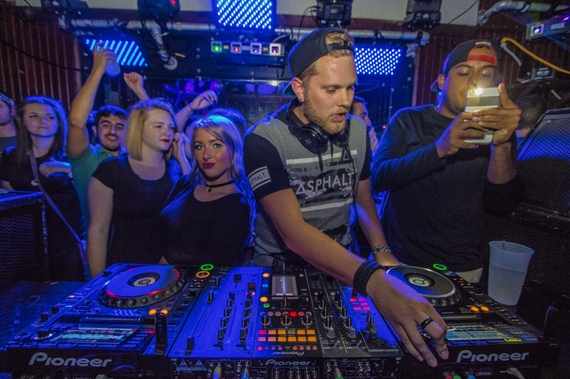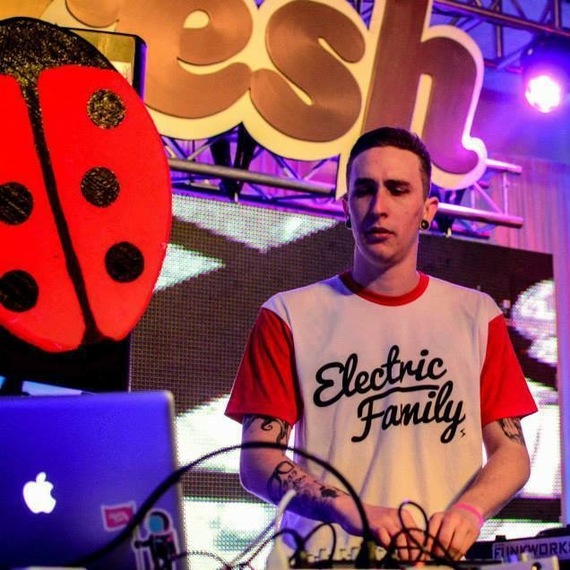The walls of Dunnkirk bar shake with frenzied activity as hundreds of students gather on to the small dance floor to see the DJ of the night.
As the music starts they throb in unison. Fueled only by booming bass, their heads bang and bodies roll to the audible adrenaline coming from the booth. Standing at the head of it all is electronic producer and DJ Justin Blau. He closes his eyes and reaches one hand up in the air, the other resting on a turntable.
This underground scene is one of thousands of electronic dance music (EDM) shows that happen every year, and they've only been growing. The industry has shown a 59% increase since 2012, and is now valued at $6.9 billion, according to the 2015 IMS Business Report.
What used to be a subculture confined to warehouse basements in Chicago has become a mainstream sensation. What's even more peculiar is the academic growth of electronic music. Since EDM's rise to fame, more young bassheads are trying their hand at the tape decks through electronic music production schools and university programs.
The DJs have come up from underground and into the classroom, but how did they get here?
The Rise of EDM
The beginning of electronic music is often traced to the "Disco Demolition Night" of 1979, where Chicago DJ Steve Dahl organized a ceremonial burning of disco records and other "black music" in the middle of Comiskey Park. The event quickly turned into an inner city riot, and drove the disco-lovers underground.
From then on the warehouses of Chicago and New York turned into all-night dance sessions. By the mid-'80s, DJs were remixing and producing their own tracks. It wasn't long before record stores were slammed with demands for the newest "warehouse" music.
Tom Lonsborough, a professor at the Manchester MIDI School for production, can trace his love for electronic music back to these underground shows in England.
"The tipping point for me was visiting the Music Box (an iconic electronic music venue in Manchester) to watch Mr. Scruff," Lonsborough said. "The atmosphere with the mix of electronic, funk, soul, disco and reggae blew my mind."
Thirty years later, EDM has taken an entire generation by storm. Dance music is now the fourth most popular music genre in both the United States and Canada, and EDM Festival capacities have quadrupled since 2009, according to IMS.
Despite the advances electronic music has made with pop culture, the artists behind it are often discredited for their reliance on technology.
"You don't have to spend the time learning an instrument, which irks some people," Lonsborough said. "I don't think everyone realizes that this is a complicated, often scientific, subject matter that requires a lot of practice before you get good at it."
Without this understanding, the idea has formed that anyone can produce electronic music with the simple push of a button.
"We're aware of the 'button pusher' misconception of EDM, but it's just that: a misconception," said Florida based producing artist Veorra. "In reality it involves composing, scoring, mixing, arranging, and even designing sounds. The possibilities are endless."
Despite these misconceptions, the appeal of electronic music has reached a new wave of young musicians, and the academic rise of electronic music has made it attainable to students.
Electronic Music in the Classroom
Professor John Gibson and I are seated in the mezzanine of Indiana University's Musical Arts Center. Banners commemorating classical composers and Italian operas hang from the ceiling.
Underneath their strict baroque gazes, Professor Gibson taps his feet and thumps his hands to demonstrate a classic dubstep wobble bass.
"Womp womp womp womp pow womp bum bum," he accompanies himself. "It's just amazing," he said. "Who first thought of that? That's why I try to do things in my class that are a little out of the box. That's where new things happen."
As Associate Director of Indiana University's Center for Electronic and Computer Music (CECM), Gibson has studied multiple facets within the electronic music world. A classically trained composer, he had previously worked with orchestras and chamber groups before he found his love for electronic music.
His beginning class teaches students about the tools they need to create their own electronic music. From sampling to synths, students walk away from Gibson's class with a broader understanding of production.
Fellow IU CECM professor Alicyn Warren has been teaching electronic production for over 25 years. She reminisces of her early composing days, spending hours splicing tapes together. These practices have since been modernized thanks to technological advances commonly used in electronic music production like MIDI (Musical Instrument Digital Interface).
"MIDI is a communications protocol," said Warren. "You have a keyboard and your computer, and MIDI lets them communicate with each other. You can produce these great sounds with the computer and then record that information."
"In short, there's no doubt that it's easier to get something going now than it was 20 years ago," Lonsborough said. "That being said, you still need a great musical idea, and you still need the skills to make it sound great."
As with any other genre, electronic music has a wide variety of subgenres, each with its own distinct sound, rhythm and tempo. This often attracts a variety of listeners and students.
"There's the community of composers steeped in classical music, and there's this community of EDM DJs," Gibson illustrates the two circles with his hands. "But it's all connected. There's a lot of back and forth with producing these."
This idea of connection is so central to electronic music that some production schools have integrated it into their curriculum. The Icon Collective Production School - located in Burbank, California - offers traditional classes in music business, mixing, arrangement and ear training in addition to theoretical classes like "the art of flow."
"(Art of Flow) is where you get to learn about the spiritual or emotional side of doing anything artistic," said Icon graduate, producer and DJ William Black. "It's awesome, because Collective is all about motivating each other and helping each other out."
This community-based mindset is often cited as one of the main reasons for EDM's rapid growth.
"It's really an entire culture now," said Bryant MacMahon (ZATAARA), a young Bloomington-based DJ. "It's a very accommodating and inviting atmosphere. You're welcomed the moment you step in, and I think people really like that."
With such a strong social backing, electronic music is bridging the gap between listeners and artists.
"There's a lot of interactivity in this music," said Warren. "People are sitting around with their friends showing each other the cool new beats they made. That's a really important part of it."
The Future of Electronic Music
Now that dance music has moved into the classroom and flooded the mainstream, it's hard to say where it will go. But some fans are seeing a potential threat to the artistry behind electronic production.
"I'd like to see more folks returning to music theory, or mixes that have a more dynamic range," Lonsborough said. "It feels like fewer people go digging. BPMs stay at 128 with no deviation, and it's like speaking to someone with a monotone voice."
While musical dilution is a rising concern, if today's young DJs have anything to say about it, electronic music and the culture behind it aren't going anywhere anytime soon.
"I think people talk about the EDM scene like it's a bubble that's about to burst, and I don't think that's true," said MacMahon. "I think electronic music is just getting started. It's the most evolved, adapted form of music we have, and it's only going to get weirder and better."



